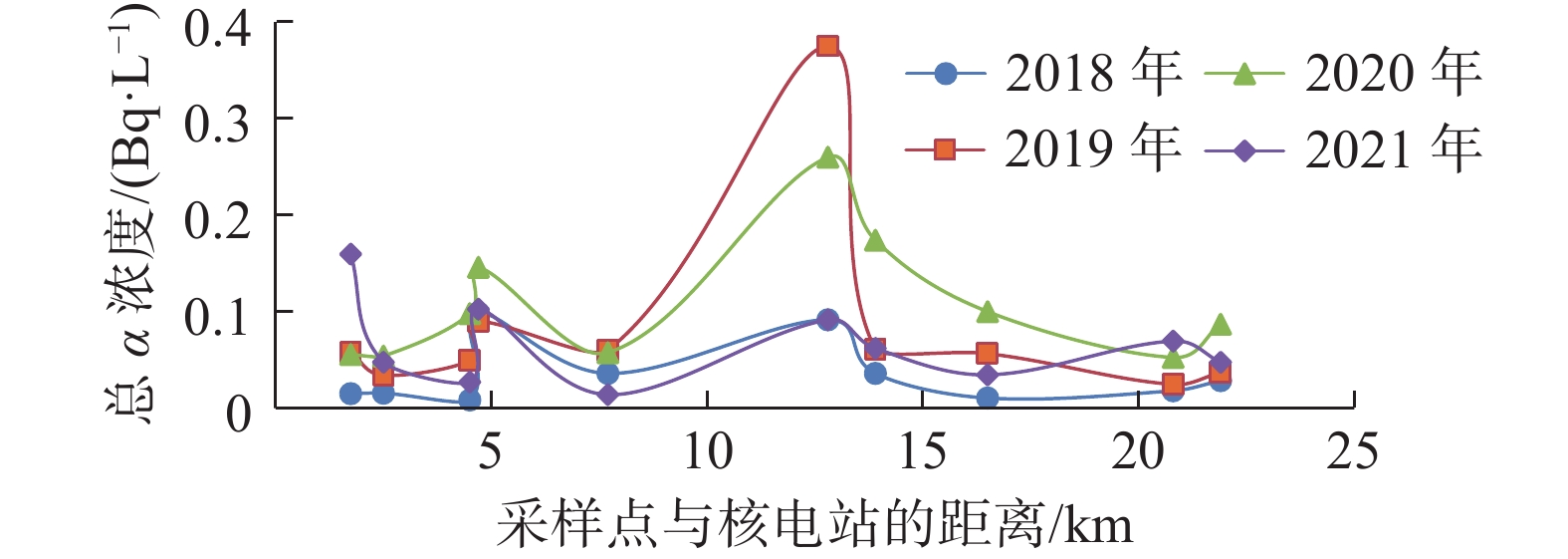石岛湾核电站,位于荣成市宁津街道地域,是我国具有自主知识产权的高温气冷堆核电站示范工程,该核电站是全球首座将四代核电技术成功商业化的示范项,2013年1月开工建设,2021年12月并网发电[1]。为了解全国首台高温气冷堆核电站对周围水环境是否产生影响,掌握基线数据,对2018—2021年石岛湾核电站周围30 km内10个饮用水采样点枯、丰水期的总α、总β放射性水平进行分析,为该核电站运行后是否对水体中的放射性影响提供基础数据支持。
1 材料与方法 1.1 采样点设置在石岛湾核电站半径30 km内主要居民点的饮用水水源设置10个监测点(详见表1)。监测点设置原则为:地表水选择预期的核电站场外流出物暴露或沉积沉降的最大地点;地下水选择在主导下风向45°扇形区内;每年延续往年选定的监测点进行采样监测。
|
|
表 1 石岛湾核电站周围30 km内的采样点 Table 1 Sampling sites within 30 km of Shidao Bay Nuclear Power Plant |
本次检测使用的设备是美国ORTEC公司的四路低本底测量(MPC 9604),该设备按规定进行仪器校准、检定,每年参加全国总α、总β放射性测量能力比对,结果均符合要求。
1.2.2 测量方法水样的处理及测量均按照《生活饮用水标准检验方法-放射性指标》[2](GB/T 5750.13—2006)要求进行,其中总α采用标准曲线法,总β采用薄样法进行数据计算。
1.3 统计方法数据建立EXCEL和SPSS双数据库,用excel分析采样点饮用水中总α、总β的数据变化趋势,用SPSS 23进行2018—2021年饮用水中总α、总β放射性水平与年份、水源、枯丰水期及核电站距离间的相关性分析,其中多组间比较采用Kruskal-Wallis检验,两样本间比较采用Spearman非参数秩和检验,P < 0.05为有相关性。
2 结果与分析本次实验对2018—2021年石岛湾核电站周围30 km内10个采样点(7个末梢水、2个出厂水、1个水源水)枯、丰水期80份饮用水中的总α、总β放射性水平进行了监测,其中距离核电站最近的采样点为宁津街道办事处2.5 km,最远为人和镇新兴自来水21.6 km(具体信息见表1),2021年沽河水厂采样点因水厂关闭更换为八河水厂,距石岛湾核电站11.5 km。
2018—2021年每年分别对10个采样点枯、丰水期的水样进行总α、总β放射性水平进行检测,测量结果见表2,2018年距离核电站4.7 km的宁津街道马家寨丰水期的总β放射性水平超过国家标准《生活饮用水卫生标准》(GB 5749—2006)[3]对总β放射性水平的限值,经过实验室复测,扣除40K影响后总β放射性水平在国家限值以下,其他采样点的总α、总β放射性水平的限值均在国家限值以下。
|
|
表 2 2018—2021年石岛湾核电站周围30 km内采样点监测数据 Table 2 Monitoring data of sampling points within 30 km around Shidaowan Nuclear Power Plant from 2018 to 2021 |
将2018—2021年采样点的总α、总β放射性水平的平均值分别用excel绘制散点图(图1、图2),分析4年来总α、总β放射性水平与距离核电站位置的变化趋势。散点图显示2018—2021年间距离核电站12.8 km处的总α水平较其他位置较高,且2018—2020年总α水平每年有上升趋势;总β放射性水平2018—2021年间的趋势变化不明显。

|
图 1 2018—2021年石岛湾核电站30 km内总α水平的变化趋势图 Figure 1 Changing trend of the gross alpha radioactivity level within 30 km around Shidaowan Nuclear Power Plant, 2018-2021 |

|
图 2 2018—2021年石岛湾核电站30 km内总β水平的变化趋势图 Figure 2 Changing trend of the gross beta radioactivity level within 30 km around Shidaowan Nuclear Power Plant, 2018-2021 |
采用SPSS.23软件录入和分析数据,将2018—2021年所有采样点枯丰水期总α、总β放射性水平的检测结果用SPSS.23软件进行Spearman双变量相关性分析,结果显示,总α、总β放射性水平与年份、水期、距核电站距离、水源类型呈现弱相关性,处理结果见表3。
|
|
表 3 2018—2021年石岛湾核电站30 km内总α、总β放射性水平的相关性(P值) Table 3 Correlation between gross alpha and gross beta radioactivity levels within 30 km around Shidaowan Nuclear Power Plant, 2018-2021 (P value) |
采用SPSS.23软件录入和分析数据,将2018—2021年的总α、总β检测结果用SPSS.23软件进行Spearman双变量相关性分析,结果显示不同年份间总β放射性水平无统计学意义(P = 0.346 > 0.05),总α放射性水平与年份有显著相关性( P = 0.00037 < 0.05)。经过按百分位数描述性统计检验得出总α放射性水平的百分位数由小到大分别为2018年、2019年、2021年、2020年,详见 表4;又将总α放射性水平与年份间进行非参数检Kruskal-Wallis检验,成对比较显示有渐进显著性,比较结果为表5。
|
|
表 4 2018—2021年年份间总α非参数检验百分位数结果 Table 4 Percentile results of non-parametric tests of gross alpha radioactivity between 2018 and 2021 |
|
|
表 5 年总α与年份间的成对比较 Table 5 Pairwise comparison of gross alpha radioactivity between years |
将2018—2021年的总α、总β检测结果采用SPSS.23软件进行Spearman双变量相关性分析,结果显示,枯丰水期与与总α、总β放射性水平差异无统计学意义(总P > 0.05)。
3 讨 论石岛湾核电站周围30 km内饮用水中总α、总β放射性水平均在国家限值以内,与其它地区水中总α、总β放射性相一致[4],与尹亮亮等[5]的《我国饮用水中总α、总β放射性数据评价》的数据相一致,2018—2021年间采样点的总α、总β放射性与水源类型无统计学意义,与其他省份调查结果有差别[6-10],分析原因首先考虑该次调查只有3种水源类型,部分水源类型的样品数偏少,代表性不足,同时与调查地区饮用水厂处理有关系,需通过增加样本量等手段进一步调查,其次考虑荣成地区的地质结构等情况影响水中放射性物质[11];饮用水中总α、总β放射性水平与枯丰水期无相关性,与海阳核电站运行前30 km内的饮用水中总α、总β放射性调查[12]基本一致;2018—2021年间的总α放射性水平非参数检验时差异具有统计学意义(P = 0.00037 < 0.05),总α放射性水平的百分位数由小到大分别为2018、2019、2021、2020年,现无查到相关数据与该次调查结果相比较。
鉴于石岛湾核电站为我国第一台高温气冷堆,需继续对核电站周围水体以及周围城市饮用水的放射性进行长期关注。
| [1] | |
| [2] |
中华人民共和国卫生部. GB/T 5750.13—2006 生活饮用水标准检验方法放射性指标[S].北京: 中国标准出版社, 2007. Ministry of Health of the People's Republic of China. GB/T5750.13—2006 Standard examination methods for drinking water - Radiological parameters[S]. Beijing: Standards Press of China, 2007. |
| [3] |
中华人民共和国卫生部, 中国国家标准化管理委员会. GB 5749—2006 生活饮用水卫生标准[S].北京: 中国标准出版社, 2007. Ministry of Health of the People's Republic of China. GB 5749—2006 Standards for drinking water quality[S].Beijing: Standards Press of China, 2007. |
| [4] |
曾亚楠, 朱晓明, 姚誉阳, 等. 2014—2019年无锡市环境样品总和总β放射性水平调查[J]. 中国辐射卫生, 2022, 31(1): 17-22. Zeng YN, Zhu XM, Yao YY, et al. Gross α and gross β radioactivity of environmental samples in Wuxi, China, 2014-2019[J]. Chin J Radiol Health, 2022, 31(1): 17-22. DOI:10.13491/j.issn.1004-714X.2022.01.004 |
| [5] |
尹亮亮, 吉艳琴, 申宝鸣, 等. 我国饮用水中总α、β放射性数据评价[J]. 中国辐射卫生, 2011, 20(1): 1-5. Yin LL, Ji YQ, Shen BM, et al. Overview on the gross α, gross β survey data in the nationwide drinking water[J]. Chin J Radiol Health, 2011, 20(1): 1-5. DOI:10.13491/j.cnki.issn.1004-714X.2011.01.036 |
| [6] |
雷家杰, 谢萍, 赵新春, 等. 防城港核电站周围地区饮用水放射性水平调查[J]. 应用预防医学, 2018, 24(3): 192-194, 197. Lei JJ, Xie P, Zhao XC, et al. Investigation of drinking water radioactivity levels in the area around Fangchenggang Nuclear Power Plant[J]. Appl Prev Med, 2018, 24(3): 192-194, 197. DOI:10.3969/j.issn.1673-758X.2018.03.007 |
| [7] |
马永忠, 万玲, 王文海, 等. 北京市生活饮用水中总放射性的测量[J]. 中华放射医学与防护杂志, 2003, 23(6): 465-467. Ma YZ, Wan L, Wang WH, et al. Measurement of total radioactivity in drinking water in Beijing[J]. Chin J Radiol Med Prot, 2003, 23(6): 465-467. DOI:10.3760/cma.j.issn.0254-5098.2003.06.033 |
| [8] |
王延俊, 亢凤琴, 罗伟立, 等. 2008 年—2011年兰州市及周边地区生活饮用水、地下水及沟渠水的放射性水平分析[J]. 中国卫生检验杂志, 2014, 24(19): 2869-2871. Wang YJ, Kang FQ, Luo WL, et al. Analysis of the areas radioactivity level of drinking water, groundwater and ditch water in Lanzhou city 2008-2011[J]. Chin J Health Lab Technol, 2014, 24(19): 2869-2871. |
| [9] |
吴玉霞, 符移才, 谈卓章, 等. 上海市某区生活饮用水中总α、总β放射性水平的测定[J]. 上海预防医学, 2022, 34(4): 340-342, 347. Wu YX, Fu YC, Tan ZZ, et al. Determination of gross α and β radioactivity of drinking water in a district in Shanghai[J]. Shanghai J Prev Med, 2022, 34(4): 340-342, 347. DOI:10.19428/j.cnki.sjpm.2022.21492 |
| [10] |
申国君. 云南省水体总α、总β放射性水平分析[J]. 环境科学导刊, 2021, 40(6): 94-96. Shen GJ. Analysis of the radiation level of total α and β in the water body of Yunnan Province[J]. Environ Sci Surv, 2021, 40(6): 94-96. DOI:10.13623/j.cnki.hkdk.2021.06.021 |
| [11] |
吕旭雅, 李慧萍, 马秀凤, 等. 2012—2021年北京市水源地放射性水平监测与评价[J]. 中国辐射卫生, 2022, 31(4): 418-423. Lyu XY, Li HP, Ma XF, et al. Monitoring and evaluation of radioactivity level in water sources in Beijing from 2012 to 2021[J]. Chin J Radiol Health, 2022, 31(4): 418-423. DOI:10.13491/j.issn.1004-714X.2022.04.006 |
| [12] |
李海亮, 陈英民, 许家昂, 等. 海阳核电站周边地区水中总α和总β放射性水平[J]. 中国辐射卫生, 2011, 20(4): 455-456. Li HL, Chen YM, Xu JA, et al. The total α and total β radioactivity levels in the water in the area around the Hai Duong Nuclear Power Plant[J]. Chin J Radiol Health, 2011, 20(4): 455-456. DOI:10.13491/j.cnki.issn.1004-714X.2011.04.002 |




